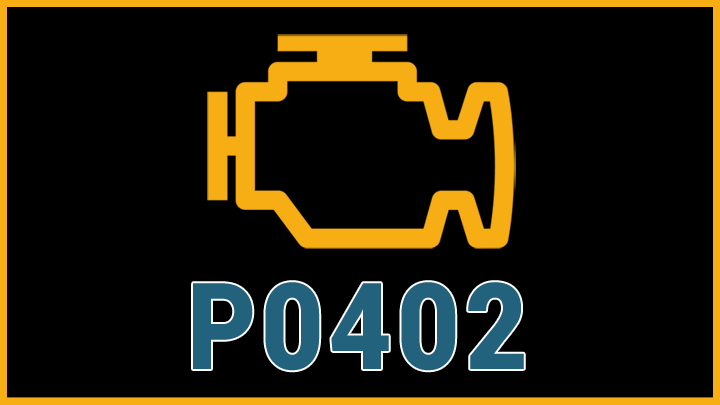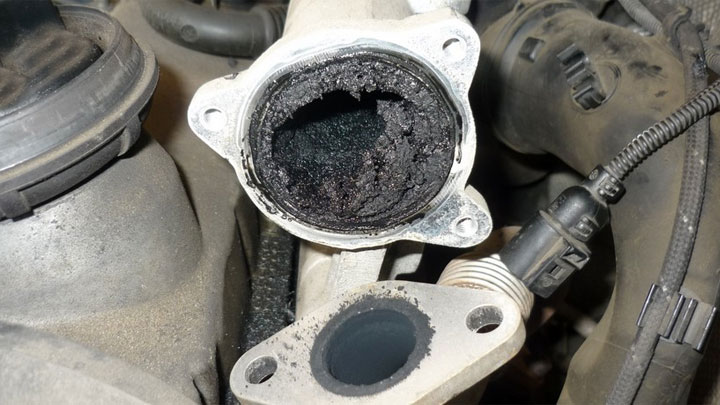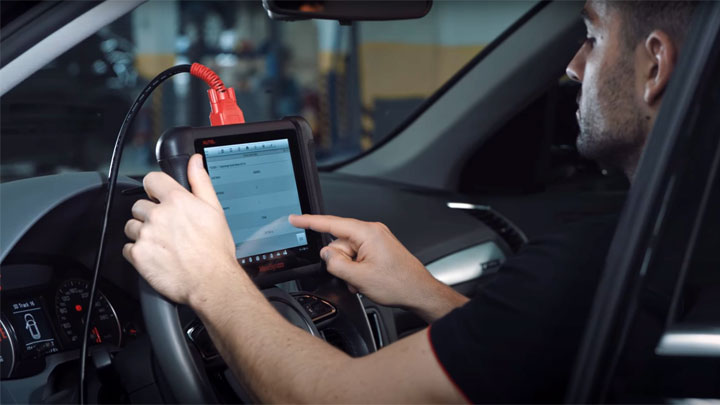P0402 Code (Symptoms, Causes, and How to Fix)
That dreaded check engine light appears… now what? Don’t panic. While most drivers fear a costly repair bill, that cryptic code often indicates a quick fix. One such example is code P0402.
In the majority of cases, DTC P0402 does not indicate a major mechanical or electrical failure. Here’s what causes a P0402 code and how to properly fix it.

What Does Code P0402 Mean?
DTC P0402 indicates that excessive or improperly timed exhaust gas flow is being allowed to recirculate into the intake manifold of the affected vehicle’s engine. As a result, the vehicle’s ECM has registered an emissions-related DTC (P0402).
To better understand the meaning behind a P0402 fault code, one must first familiarize themselves with the principles of EGR valve operation.
In the 1970s, a host of anti-smog legislation was passed into law, thereby mandating the reduction of emissions output by production vehicles. As a result, automotive manufacturers began experimenting with various means of reducing exhaust-related pollutants. One such method, which proved successful, is the idea of EGR (exhaust gas recirculation).
This principle centers around the recycling of exhaust gasses, into an engine’s intake tract, in a bid to burn all combustible materials, in as complete a fashion as possible. Systems of this type rely upon EGR valves to meter the amount of exhaust gasses recirculated into an engine’s intake.
When an engine is not up to operating temperature, a properly operating EGR valve should restrict the recirculation of exhaust gasses. However, an EGR valve should gradually open as an engine warms, thereby reducing emissions output.
When a P0402 DTC has been set, a vehicle’s ECM has determined that an excessive volume of exhaust gasses have been introduced into the engine’s intake tract.
Related DTC: Code P0400, Code P0401, Code P0403, Code P0404, Code P0405
Symptoms of Code P0402
Numerous symptoms are associated with the onset of a P0402 diagnostic trouble code. However, these symptoms often vary on a case-by-case basis and might differ substantially from one make or model of vehicle to the next.
The following are the most common symptoms associated with DTC P0402.
- Sudden illumination of a check engine light
- Rough, or unstable idle
- Potential exhaust leaks
Causes of Code P0402

While many motorists automatically fault a vehicle’s EGR valve when a P0402 trouble code has been set, this is only one of several possibilities that exist as the potential root cause of such a DTC.
One should always conduct a thorough diagnosis of any such issue, before condemning individual components. The following are the most common causes of a P0402 fault code.
- Carbon fouled EGR Valve
- Faulty EGR valve
- Lack of vacuum to EGR valve
- Failed differential pressure/temperature sensor
- Damage EGR electrical circuit
- ECM/PCM related software issues
Is Code P0402 Serious?
The sudden onset of a P0402 DTC is a relatively serious issue, due to potential ramifications toward vehicle drivability. In many cases, vehicle idling can be negatively impacted to the point of stalling, thereby causing unanticipated issues when coming to a stop at a traffic light or stop sign.
It is also important to understand that EGR-related issues can compound over time if left unaddressed. This is especially true if carbon fouling is to blame for your vehicle’s P0402 DTC. As time passes, this carbon fouling will continue to build, further complicating any cleaning that will eventually take place.
See Also: Best Fuel System Cleaners
How to Fix

In the vast majority of cases, remedying the root cause of a P0402 diagnostic trouble code is not as difficult as one might initially believe. However, the efficiency of this repair process hinges upon one’s ability to assess the issue at hand and make an accurate diagnosis.
The following steps will assist you in fixing the root cause of your vehicle’s P0402 trouble code.
#1 – Check For Additional DTCs
Before beginning the diagnostic process, use a quality OBD-II scan tool to check for the presence of additional DTCs. Carefully diagnose any additional active codes, in a bid to rule out a connection with the offending P0402 DTC.
#2 – Visually Inspect All Related Wiring And Hoses
Next, you will perform a careful visual inspection of all vacuum hoses and electrical connectors which correspond to your engine’s EGR valve.
Check each attached vacuum hose for any signs of dry-rot, cracks, or obvious deterioration. Replace any such hoses that are found to be defective.
You should also inspect any wiring which connects to the engine’s EGR valve, for breaks or signs of chafing. Any damage that is found should be repaired immediately.
#3 – Remove EGR Valve Mounting Hardware
If a test drive confirms the reoccurrence of DTC P0402, visual inspection of the engine’s EGR valve will be necessary. In order to do so, all corresponding fasteners must be removed from the EGR valve’s mounting flange.
If heavy carbon build-up is found around the EGR valve’s plunger, such deposits can be removed with the use of a pipe cleaning brush and throttle body cleaner.
#4 – Test Vacuum Actuated EGR Valve
If your vehicle’s engine features a vacuum-actuated EGR, a vacuum pump can be used to test unit functionality. This pump should be plumbed to the EGR valve’s vacuum nipple, and a slight vacuum should be applied.
If the valve’s plunger does not actuate, the EGR valve is to be considered suspect.
#5 – Test Electronically Actuated EGR Valve
If your vehicle features an electronically actuated EGR valve, a bi-directional scan tool can be used to validate the unit’s operation. With a scan tool of this nature hooked to the vehicle’s OBD-II data port, the EGR valve can be commanded to a set position.
If no plunger actuation is noted, an electrical circuit fault, or EGR motor fault is to blame. Further electrical testing will be necessary.
#6 – Check Live Data
If EGR valve functional testing has revealed no issues, you should consult live streaming data from your engine’s sensors, in a bid to secure a diagnosis. Before beginning this process, reinstall your engine’s EGR valve, torqueing all previously removed hardware.
With the use of an OBD-II scan tool with live data capabilities, monitor all EGR-related temperature and pressure signals, while comparing collected data to the manufacturer specified values.
Replace any sensor that is deemed faulty during this process. If DTC P0402 persists, attention should turn to the vehicle’s ECM programming.
- P0480 Code (Symptoms, Causes, and How to Fix) - Apr 19, 2024
- Car Temperature Gauge Stopped Working? (Here’s Why) - Apr 15, 2024
- Ignition Coil vs Coil Pack (What’s the Difference?) - Apr 8, 2024

my ford 2008 mustang always get this p0402 code, everytime i delete it from system with my obd scanner but the code occurs again after 1 week. What should i do ?
It’s probably a physical problem with the EGR valve. You may have to take apart the EGR valve, inspect it, clean it, and replace any parts of the EGR system that have gone bad.
I’m trying to figure out what the parts name is for the egr to attached to, it’s not the intake manifold, but the yoke or whatever the part is that the egr valve attaches to for a 2002 f150